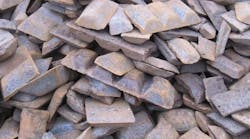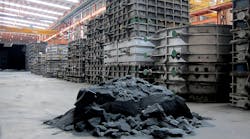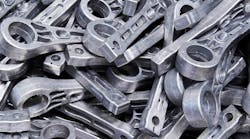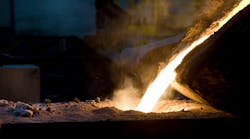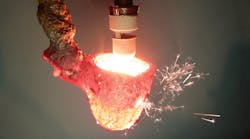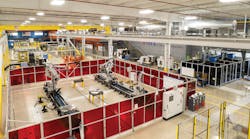American ingenuity” is more than a phrase: it’s also a reality. In 1989, Chesapeake Specialty Products had a vision that foundrymen could create better castings if they were able to make cores and molds that were mechanically stable under rapid temperature changes and produced less gas. If thermal distortion could be controlled, veining and penetration would be prevented. The gas defects could be eliminated if a way could be found to tie up the gas coming from the burnt resin. Chesapeake Specialty Products soon introduced the SphereOx® sand additive, a spherical shaped particle that for the past 18 years has prevented casting defects while reducing overall resin cost.
As molten metal enters the mold, the typical resin sand begins to expand. Silica sand expands at a rate of about 2%. This expansion flex often thermally fractures the bond between the sand grains and resin, causing veining. Sand additives were introduced to soften the core and allow it to expand without fracturing the sand/resin bond. Most of these oxides and additives are angular in shape (like shingles on a roof) and require considerably larger volumes of resin to achieve proper adhesion, unlike the spherically shaped SphereOx particle that, due to its unique spherical shape requires 20-30% less resin for proper adhesion.
enters the mold, generating gas. The more resin used, the more gas is generated as it burns. This off-gassing causes pinhole and blowhole defects in castings.
As resin burns out of the core and mold, voids are created where the resin once was. Molten metal penetrates into these voids and the casting suffers a “burn-in” defect, and is usually scrapped. SphereOx requires less resin, which allows for tighter compaction. More importantly, as molten metal heats the sand, the SphereOx particles soften, filling in the voids left by the resin. The result is a clean casting with no burn-in or penetration. Lower resin cost and better castings – a very profitable combination.
Recent tests conducted at a large steel foundry prove that SphereOx particles in the outer surface of the core actually bond with the core-side surface of the core wash. A barrier is created which resists metal penetration. This testing also shows that the chemical integrity of the core wash used with SphereOx remains intact and its thermal conductivity increased. EPMA (Electron probe micro-analysis) scans showed that without SphereOx, the zircon wash was destroyed. With SphereOx, the EPMA showed that the wash remained intact and protected the surface of the casting. The result is that the casting surface remains smooth, as opposed to a rough surface when the wash was used without SphereOx.
The SphereOx particle is manufactured to the shape of the highest quality spherical sand, sized at AFS 70. It is highly magnetic and there are no dusty impurities. A drum type-magnetic sand reclamation system will remove the SphereOx particles from the used sand grains so the SphereOx does not get reclaimed with the sand. Many foundries worldwide successfully use SphereOx with reclamation systems. SphereOx works with new sand or reclaimed sand.
It has been established that the use of SphereOx as a sand additive will prevent veining, penetration, and gas defects, but (as previously mentioned) being nearly pure iron, the SphereOx particles thermally conduct a tremendous amount of heat away from the molten metal creating a strong “chill” against molten metal. Also, because the SphereOx particle is nearly pure iron, it starts to soften and spread among the sand grains at about 2015 F, creating a barrier to resist penetration. The developers of SphereOx realized that these attributes could be combined with a high-purity insulating refractory. Radiated heat would then be pulled away from the mold/metal interface, minimizing the negative effects of thermal distortion and metal penetration. Thus, the SphereCoat core/mold coating was formulated. Studies and field trials show that the performance characteristics of the SphereCoat core/mold coating are very similar to those of high performance zircon enriched core washes.
The ceramic composite of SphereCoat impregnates the surface of the core to a depth of three sand grains. This creates a barrier that resists the negative effects associated when thermomechanical and thermo-chemical forces attack the sand core during the pour. By pulling radiant heat away from the core, penetration and burn-in defects are prevented, and smooth casting finishes can be expected.
The performance of the SphereCoat coating is comparable to that of a zircon wash, but as foundrymen have come to know, the price of zircon continues to skyrocket and the availability is limited. SphereCoat offers the same performance, but foundries will save an average of 40% by converting from a zircon wash to SphereCoat.
Investment casters are constantly striving for smooth final surface finishes and dimensional stability. A poor quality surface finish will increase machining costs, or worse yet create scrap. The control process begins with formulating primary ceramic slurry to coat the wax pattern. Zircon flour is often used as the ingredient in the primary slurry that limits thermo-chemical reactions from occurring at the mold/metal interface, and thus prevents burn-in/burn-on casting defects.
The SphereCoat primary slurry blend is a proprietary formulation blended with the same SphereOx particle used to control burn-in defects. It is a direct replacement for zircon flour, but at half the price.
More information is available from Chesapeake Specialty Products Inc. Visit www.chesprod.com
